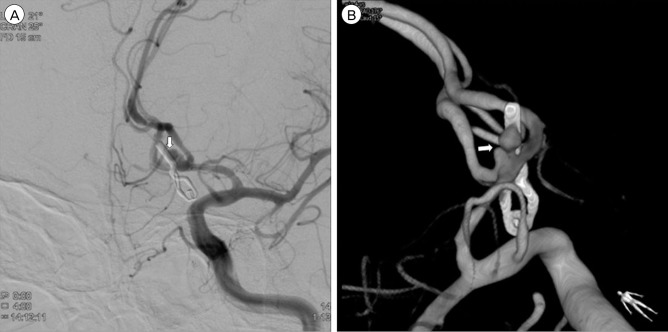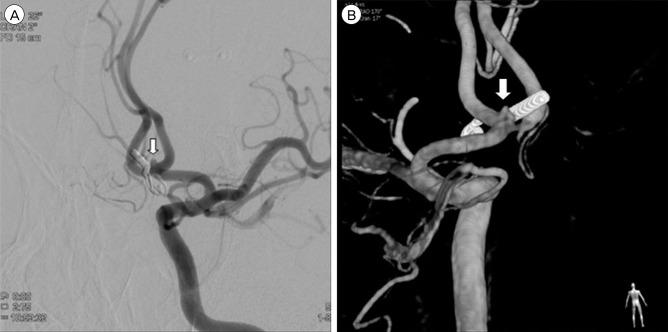J Cerebrovasc Endovasc Neurosurg.
2016 Dec;18(4):402-406. 10.7461/jcen.2016.18.4.402.
Spontaneous Regression of Aneurysm Remnant after Incomplete Surgical Clipping in a Patient with Ruptured Cerebral Aneurysm
- Affiliations
-
- 1Department of Neurosurgery, Hallym University Sacred Heart Hospital, Anyang, Korea. nscib71@gmail.com
- KMID: 2367334
- DOI: http://doi.org/10.7461/jcen.2016.18.4.402
Abstract
- Cases of spontaneous regression of cerebral aneurysm remnant after incomplete surgical clipping have been rarely reported. This paper reports the regression of an aneurysm remnant after incomplete surgical clipping during postsurgical follow-up. A 50-year-old male presented with subarachnoid hemorrhage because of rupture of an anterior communicating artery aneurysm. An emergency clipping of the aneurysm was performed. A cerebral angiography, which was performed two weeks postoperatively, revealed an aneurysm remnant. The patient refused additional treatment and was discharged without apparent neurological deficit. One-year follow up cerebral angiography demonstrated a partially regressed aneurysm remnant.
MeSH Terms
Figure
Cited by 1 articles
-
Rescue endovascular treatment for rapid regrowth of aneurysm remnant on middle cerebral artery trunk after unsuccessful surgical clipping in patients with a ruptured cerebral aneurysm: A report of two cases
Hyun Wook Cho, Donghwan Jang, Hyo Sub Jun
J Cerebrovasc Endovasc Neurosurg. 2021;23(2):117-122. doi: 10.7461/jcen.2020.E2020.08.004.
Reference
-
1. Bavinzski G, Talazoglu V, Killer M, Gruber A, Richling B, al-Shameri R. Coiling of recurrent and residual cerebral aneurysms after unsuccessful clipping. Minim Invasive Neurosurg. 1999; 3. 42(1):22–26. PMID: 10228935.
Article2. Choi CY, Han SR, Yee GT, Lee CH. Spontaneous regression of an unruptured and non-giant intracranial aneurysm. J Korean Neurosurg Soc. 2012; 9. 52(3):243–245. PMID: 23115669.
Article3. David CA, Vishteh AG, Spetzler RF, Lemole M, Lawton MT, Partovi S. Late angiographic follow-up review of surgically treated aneurysms. J Neurosurg. 1999; 9. 91(3):396–401. PMID: 10470813.
Article4. Deshmukh VR, Kakarla UK, Figueiredo EG, Zabramski JM, Spetzler RF. Long-term clinical and angiographic follow-up of unclippable wrapped intracranial aneurysms. Neurosurgery. 2006; 3. 58(3):434–442. discussion 434-42. PMID: 16528182.
Article5. Drake CG, Friedman AH, Peerless SJ. Failed aneurysm surgery. Reoperation in 115 cases. J Neurosurg. 1984; 11. 61(5):848–856. PMID: 6491730.6. Ebina K, Suzuki M, Andoh A, Saitoh K, Iwabuchi T. Recurrence of cerebral aneurysm after initial neck clipping. Neurosurgery. 1982; 12. 11(6):764–768. PMID: 7162566.
Article7. Feuerberg I, Lindquist C, Lindqvist M, Steiner L. Natural history of postoperative aneurysm rests. J Neurosurg. 1987; 1. 66(1):30–34. PMID: 3783256.
Article8. Giannotta SL, Litofsky NS. Reoperative management of intracranial aneurysms. J Neurosurg. 1995; 9. 83(3):387–393. PMID: 7666212.
Article9. Hamilton MG, Dold ON. Spontaneous disappearance of an intracranial aneurysm after subarachnoid hemorrhage. Can J Neurol Sci. 1992; 8. 19(3):389–391. PMID: 1393850.
Article10. Jayakumar PN, Ravishankar S, Balasubramaya KS, Chavan R, Goyal G. Disappearing saccular intracranial aneurysms: do they really disappear? Interv Neurol. 2007; 9. 13(3):247–254.
Article11. Johnston SC, Dowd CF, Higashida RT, Lawton MT, Duckwiler GR, Gress DR, et al. Predictors of rehemorrhage after treatment of ruptured intracranial aneurysms: the Cerebral Aneurysm Rerupture After Treatment (CARAT) study. Stroke. 2008; 1. 39(1):120–125. PMID: 18048860.12. Kang HS, Han MH, Kwon BJ, Jung SI, Oh CW, Han DH, et al. Postoperative 3D angiography in intracranial aneurysms. AJNR Am J Neuroradiol. 2004; 10. 25(9):1463–1469. PMID: 15502122.13. Le Roux PD, Elliott JP, Eskridge JM, Cohen W, Winn HR. Risks and benefits of diagnostic angiography after aneurysm surgery: a retrospective analysis of 597 studies. Neurosurgery. 1998; 6. 42(6):1248–1254. discussion 1254-5. PMID: 9632182.
Article14. Lee JH, Kim SJ, Cha J, Kim HJ, Lee DH, Choi CG, et al. Postoperative multidetector computed tomography angiography after aneurysm clipping: comparison with digital subtraction angiography. J Comput Assist Tomogr. 2005; Jan-Feb. 29(1):20–25. PMID: 15665677.15. Lin T, Fox AJ, Drake CG. Regrowth of aneurysm sacs from residual neck following aneurysm clipping. J Neurosurg. 1989; 4. 70(4):556–560. PMID: 2926496.
Article16. Rabinstein AA, Nichols DA. Endovascular coil embolization of cerebral aneurysm remnants after incomplete surgical obliteration. Stroke. 2002; 7. 33(7):1809–1815. PMID: 12105358.
Article17. Sindou M, Acevedo JC, Turjman F. Aneurysmal remnants after microsurgical clipping: classification and results from a prospective angiographic study (in a consecutive series of 305 operated intracranial aneurysms). Acta Neurochir (Wien). 1998; 140(11):1153–1159. PMID: 9870061.
Article18. Tan CB, Rodesh G, Lasjaunias P. Growth and spontaneous regression of a middle cerebral artery aneurysm after surgical clipping. Interv Neuroradiol. 2001; 6. 7(2):147–151. PMID: 20663342.
Article
- Full Text Links
- Actions
-
Cited
- CITED
-
- Close
- Share
- Similar articles
-
- Rescue endovascular treatment for rapid regrowth of aneurysm remnant on middle cerebral artery trunk after unsuccessful surgical clipping in patients with a ruptured cerebral aneurysm: A report of two cases
- Surgical Experience of Recurrent Hemorrhage from the Regrowth Cerebral Aneurysm after Initial Neck Clipping: Case Report
- Early Postoperative Cerebral Angiography After Clipping in Patients with Ruptured Aneurysm: its Usefulness and Indications
- Traumatic Rupture of Middle Cerebral Artery Aneurysm
- Surgical Clipping of Intracranial Aneurysm Regrown after Endovascular Coiling




